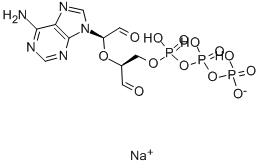ADENOSINE 5'-TRIPHOSPHATE,PERIODATE OXIDIZED SODIUM SALT

ADENOSINE 5'-TRIPHOSPHATE,PERIODATE OXIDIZED SODIUM SALT structure
|
Common Name | ADENOSINE 5'-TRIPHOSPHATE,PERIODATE OXIDIZED SODIUM SALT | ||
|---|---|---|---|---|
| CAS Number | 71997-40-5 | Molecular Weight | 571.11 | |
| Density | N/A | Boiling Point | N/A | |
| Molecular Formula | C10H11N5Na3O13P3 | Melting Point | N/A | |
| MSDS | USA | Flash Point | N/A | |
|
Involvement of a P2X7 Receptor in the Acrosome Reaction Induced by ATP in Rat Spermatozoa.
J. Cell Physiol. 230 , 3068-75, (2015) The acrosome reaction (AR) is the exocytosis of the acrosomal vesicle in response to different physiological and non-physiological stimuli. Particularly in mammals, the AR is needed for sperm to fuse with the oocyte plasma membrane, and it occurs only in capa... |
|
|
P2X1 Receptor Antagonists Inhibit HIV-1 Fusion by Blocking Virus-Coreceptor Interactions.
J. Virol. 89 , 9368-82, (2015) HIV-1 Env glycoprotein-mediated fusion is initiated upon sequential binding of Env to CD4 and the coreceptor CXCR4 or CCR5. Whereas these interactions are thought to be necessary and sufficient to promote HIV-1 fusion, other host factors can modulate this pro... |
|
|
Cell stress increases ATP release in NLRP3 inflammasome-mediated autoinflammatory diseases, resulting in cytokine imbalance.
Proc. Natl. Acad. Sci. U. S. A. 112(9) , 2835-40, (2015) Cell stress is implicated in triggering bouts of systemic inflammation in patients with autoinflammatory disorders. Blood monocytes from patients affected by NLRP3-mediated cryopyrin-associated periodic syndromes (CAPS) release greater amounts of IL-1β than m... |
|
|
TLR costimulation causes oxidative stress with unbalance of proinflammatory and anti-inflammatory cytokine production.
J. Immunol. 192(11) , 5373-81, (2014) IL-1β acts in concert with anti-inflammatory cytokines, in particular, IL-1R antagonist (IL-1Ra), to ensure the correct development and outcome of the inflammation: imbalance in the IL-1β/IL-1Ra ratio is implicated in many human diseases and may lead to drama... |
|
|
Potentiation of temozolomide antitumor effect by purine receptor ligands able to restrain the in vitro growth of human glioblastoma stem cells.
Purinergic Signal. 11 , 331-46, (2015) Glioblastoma multiforme (GBM), the most common and aggressive brain tumor in humans, comprises a population of stem-like cells (GSCs) that are currently investigated as potential target for GBM therapy. Here, we used GSCs isolated from three different GBM sur... |
|
|
The NLRP3 inflammasome is activated by nanoparticles through ATP, ADP and adenosine.
Cell Death Dis. 6 , e1629, (2015) The NLR pyrin domain containing 3 (NLRP3) inflammasome is a major component of the innate immune system, but its mechanism of activation by a wide range of molecules remains largely unknown. Widely used nano-sized inorganic metal oxides such as silica dioxide... |
|
|
The ectoenzyme E-NPP3 negatively regulates ATP-dependent chronic allergic responses by basophils and mast cells.
Immunity 42(2) , 279-93, (2015) Crosslinking of the immunoglobulin receptor FcεRI activates basophils and mast cells to induce immediate and chronic allergic inflammation. However, it remains unclear how the chronic allergic inflammation is regulated. Here, we showed that ecto-nucleotide py... |
|
|
P2X7 receptor modulates inflammatory and functional pulmonary changes induced by silica.
PLoS ONE 9(10) , e110185, (2014) Silicosis is an occupational lung disease, characterized by irreversible and progressive fibrosis. Silica exposure leads to intense lung inflammation, reactive oxygen production, and extracellular ATP (eATP) release by macrophages. The P2X7 purinergic recepto... |
|
|
The Beneficial Effects of P2X7 Antagonism in Rats with Bile Duct Ligation-induced Cirrhosis.
PLoS ONE 10 , e0124654, (2015) Splanchnic angiogenesis in liver cirrhosis often leads to complications as gastroesophageal variceal hemorrhage and the treatment efficacy is adversely affected by poor portal-systemic collateral vasoresponsiveness related to nitric oxide (NO). Purinergic rec... |
|
|
Effect of enterohaemorrhagic Escherichia coli O157:H7-specific enterohaemolysin on interleukin-1β production differs between human and mouse macrophages due to the different sensitivity of NLRP3 activation.
Immunology 145 , 258-67, (2015) Enterohaemorrhagic Escherichia coli (EHEC) O157:H7 infection in humans can cause acute haemorrhagic colitis and severe haemolytic uraemic syndrome. The role of enterohaemolysin (Ehx) in the pathogenesis of O157:H7-mediated disease in humans remains undefined.... |